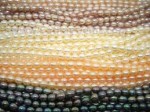How Do Pearls Get Their Color? (6/15/2011)
 Understanding Pearl Color
Understanding Pearl Color
A pearl’s color is known as a combination of its bodycolor as well as its overtone. Bodycolors can be divided into two groups: cool hues and warm hues. Cool hues range between red-purple colors to yellow-colored green while warm hues range from purple red-colored to greenish yellow. Overtone is considered the overlying color which appears to drift over the top of the pearl.
“Cultivating” Pearl Color
Pearls are available in a multitude of colors, many different from bright white to black. At this point (just as the majority of the characteristics associated with pearls), the reality that the pearl is undoubtedly an organic and natural treasure, made within a living creature, adds to the countless distinctive ways its pigmentation can be cultivated.
Pearl “Bodycolor”
Natural color of a pearl is because of a variety of reasons. The pearl’s bodycolor is also its main color. This will be bright white, silver, cream-colored, gold, green, blue, or black. The actual bodycolor depends upon the type of oyster or mollusk that produces the actual pearl (particular types of oysters typically create pearls of specific colors), together with the conditions of the water, and quite often the sort of nucleus which is placed in order to induce the pearl’s production.
“Overtones” In Pearl Color
Overtones are transparent shades, that often show up upon the top of a pearl’s primary bodycolor. These types of overtones frequently have an affect on the bodycolor to some extent, as well as imparting depth and glow. A pearl could be the white kind of with rose overtones, for example. A few pearls will not have any existing overtones at all.
“Pearl Orient”
The term orient means the glistening, iridescent colors, that appear to move as well as sparkle when the pearl is rotated.This particular sensation can be activated by means of light reflected using the different thin layers of nacre, from the pearl.
Artificially Colored Pearls
You should note that a lot of pearls tend to be synthetically colored. This is now extensively employed with freshwater, akoya, as well as Tahitian pearls. The colors tend to be synthetically incorporated using a treatment referred to as dyeing, or by submitting the pearls to irradiation. Most of these processed colors tend to be simple to spot by a qualified observer who might peer along the drill hole searching for concentrations of color, which in turn indicates the use of dye, or possibly a darkish pearl nucleus, which signifies radiation treatment.
Pearl Color And Black Pearls
One guideline in recognizing treated pearls is if the pearls are not genuine Tahitian pearls, within the Black Lip Oyster (Pinctada margaritifera), they cannot naturally be black. Naturally black akoya and freshwater pearls do not occur, and whenever black pearls of these selections are found on the market, they are dyed. Numerous unwary consumers purchase black pearls, merely to find out later on the color is fake.
New Freshwater Pearl Colors
In the 1930’s, fresh water pearls via Japan’s Lake Biwa produced a wide variety of new colors into the pearl marketplace – colors that have been formerly not available in saltwater pearls. Today, Chinese fresh water pearl farmers have extended this trend with many different pretty colored pearls collected in big amounts.


Comments are closed.